How To Get Scratches Out of Stainless Steel
Author: Anne Cowart | Editor: Omar Alonso
Review & Research: Jen Worst & Chris Miller
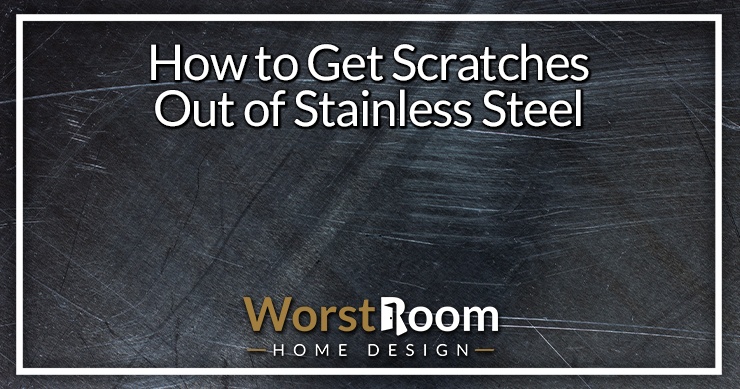
Regarding appliance coatings, stainless steel is by far the most popular option. It’s fashionable, exquisite, practical, and long-lasting. But despite its durability, steel might develop unattractive scratches due to regular use. Let's find out how to get scratches out of stainless steel.
Luckily, restoring your stainless steel appliances’ original condition is possible with the right materials and cleaning agents. So, if you’ve been wondering how to deal with these unsightly scratches, here’s the answer.
Examine the Stainless Steel
If you examine closely, a stainless steel surface appears to have brush markings. That appearance is known as the “grain,” an outcome of the production process. It would be best to always rub in the grain’s direction while attempting to remove scratches, regardless of your technique or substance. Rubbing in the opposite direction will only amplify the problem.
It’s also important to consider the type of scratches you’re dealing with. Some tend to be superficial, while others are more noticeable. Your approach will vary according to your stainless steel’s current state.
What Materials Do I Need for Fine Scratches?
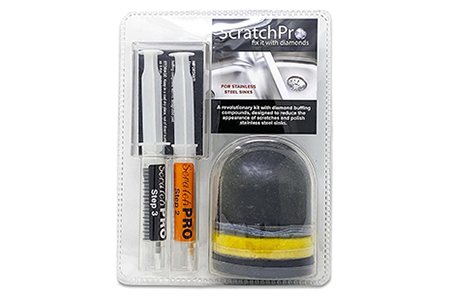
If the scratches aren’t too severe, you’ll require a stainless-steel scratch removal formula that’s non-abrasive. You can find effective commercial products designed specifically for this purpose. You might experiment with home items like baking soda and toothpaste (non-gel). Besides that, you’ll require microfiber cloths to apply and remove the substance.
How Do I Remove Fine Scratches in Stainless Steel?
If your stainless steel has fine scratches, the first thing you do is prepare your non-abrasive compound. You can find them in powder form or already in paste form. If you’re using baking soda, you’ll need to add water until you achieve a consistent paste. You don’t need any water if you’re using non-gel toothpaste. Here’s how to get fine scratches out of stainless steel:
- Ensure the surface is free of any debris traces or leftover food particles. Never clean stainless steel with Windex or ammonia-based cleaners.
- Afterward, apply the cleaning compound on a microfiber cloth and repeatedly massage it over the affected area. Be gentle, and be sure to work with the grain.
- Let it rest for a few minutes, and start wiping the compound off using a fresh, wet microfiber cloth to assess the results. If the scratch needs further polishing, continue until you achieve better outcomes.
- Using the damp towel, remove any excess compound before drying the area with a fresh one.
Please take note that we're using the word "massage" here. We are not suggesting any vigorous scrubbing. That's the opposite of how to get scratches out of stainless steel. That's why we're even suggesting a gentle microfiber cloth.
What Materials Do I Need for Deep Scratches?
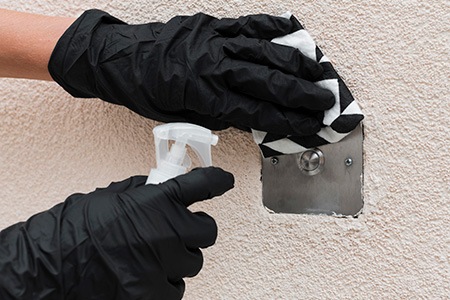
If the scratch is deep or stubborn, you might need an abrasive pad to smooth it out. You’ll need some cooking oil (preferably olive oil), a cleaning sponge, or a scouring pad. Commercial kits like the one above also come with everything you need to remove deeper scratches.
Remember, you should only use this method for stainless steel that’s not coated. The process will result in more damage if the steel has a synthetic surface or coat.
How Do I Remove Deep Scratches in Stainless Steel
You’ll need a scratch removal kit if the scratches don’t disappear after applying a cleaning compound. Most scratch repair kits include abrasive pads and polishing compounds. To bring back your stainless steel luster, you’ll need to start with the rough grit and work your way up to the lightest. You’ll need to refer to the manufacturer’s guide to get the best results from your kit.
Here’s how to remove deep scratches in stainless steel:
- Learn everything there’s to know about the manufacturer’s guidelines. Determine your stainless steel’s grain orientation.
- Get the right grip pad for the scratch you want to remove. Then, start rubbing the scratch in one direction. Going against the grain with an abrasive might leave unappealing round markings. Don’t apply more than the necessary force when removing the scratch. Avoid being aggressive or getting deeper than you should.
- If the manufacturer suggests switching to a finer grit pad, do so and keep polishing with water or the compounds contained in the kit.
- Evaluate your efforts and try again if need be. Finish by wiping the area with a microfiber cloth when you achieve satisfactory outcomes. Restore the surface’s luster by polishing it with oil.
Basically, you're not only smoothing off the ridges of the current scratch but blending it in. Please note that you'll progressively move to finer grit scrubbing pads and that while it may take some pressure, don't apply too much pressure during any stage of this process.
Causes of Scratches on Stainless Steel
It's one thing to know how to get scratches out of stainless steel, but what about preventing them altogether? Here are some of the reasons why stainless steel gets scratches:
Cleaning With Abrasive Compounds
Abrasive cleansers are great for removing the following things:
- Fingerprints
- Grime
- Stains
However, they tend to scratch stainless steel surfaces, rendering them old and worn.
The best alternative for cleaning stainless steel is detergents with low chloride content. You may also use quick-acting, non-abrasive cleaners to polish your appliances.
Leaving Items in the Sink
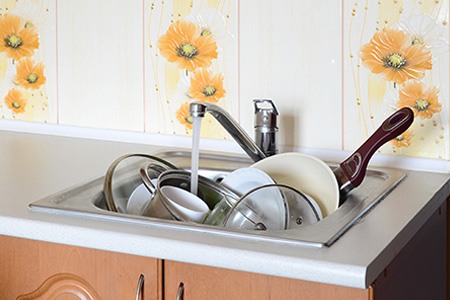
Leaving dirty items in a stainless steel sink can be enticing, but it’s a bad idea. The longer the filth rests in the sink, the more difficult it’s to clean since it leaves behind stubborn stains. The same thing happens when you leave dirty water in the sink. And then rigorous scrubbing with the wrong material creates scratches on your stainless steel sink.
After washing your pots and pans, give the sink a good scrub to remove any remaining food particles and cleaning agents. Stainless steel is waterproof, so you can soak cooked on food to soften it, but you do need to clean it gently in a reasonable amount of time.
Failure To Wipe in the Grain’s Direction
You should always do polishing and cleaning toward the steel’s grain. That permits you to clean the small crevices prone to collecting dirt and filth while maintaining their polish.
Using Abrasive Cleaning Pads, Steel Brushes, or Steel Wool
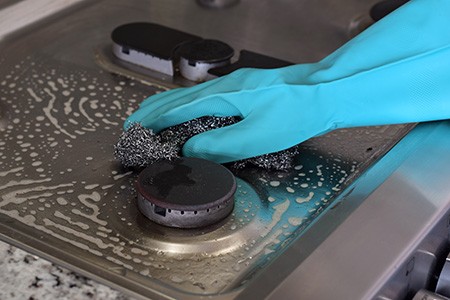
You should never use a rough sponge to clean your home appliances. Such abrasive substances scratch the steel’s grain, rendering your otherwise shiny appliances look old. Steel wool might be excellent for cleaning some kitchen surfaces, but it’s not friendly to stainless steel.
You should also avoid traditional steel brushes since their bristles can come loose and leave behind little carbon fragments that stick in the steel. The particles will begin rusting, giving the impression that the appliance is deteriorating.
Using Bleach & Chlorine
Although bleach will temporarily restore your stainless steel’s luster, it’ll eventually corrode the coating, no matter the steel coating used. Most manufacturers advise against using strong cleaning products on their equipment. Surface pitting from these corrosive compounds can trap impurities.
If you want to ensure your steel’s protective layer doesn’t suffer discoloration, avoid using glass cleaners and alcohol. It’s also not a good idea to combine different chemical cleaners, which can produce harmful fumes.
Allowing Grime to Sit
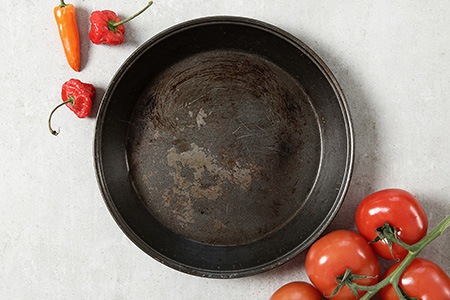
If you quickly clean up stains with a moist rag or paper towel rather than waiting for them to dry, your appliances will retain their like-new appearance for many years. Stainless steel appliances are susceptible to collecting dust, dirt, grease, and other forms of grime if you don’t clean and dry them regularly.
Your main priority is to avoid any scrubbing. You should clean up little mistakes as soon as they occur using water and a soft towel. Rubbing off the substance with warm water will do when you don’t have time to thoroughly clean and polish the area.
Using Hard Water
Even on stainless steel, streaks, and stains might be an outcome of hard water’s contact with surfaces. If you don’t have a whole-house water softener, dry stainless steel surfaces. You may scrub stubborn hard water stains using a moist cloth and a drop or two of distilled white vinegar.
How to Prevent Scratches in Your Stainless Steel
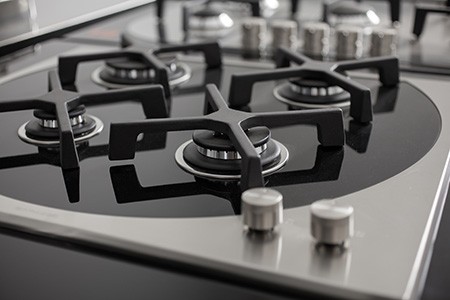
Everybody wishes stainless steel retains its gleaming appearance for as long as possible. Regular cleaning is one of the best ways to keep yours looking new and avoid scratches. Hot water is a safe and efficient cleaner that won’t corrode the steel. You may also use pure white vinegar when cleaning your stainless steel’s surface.
Maintaining a regular cleaning routine also reduces the likelihood of debris and grime building up to the point where you have to scrub too vigorously and accidentally scratch your steel’s surface. It’s essential to remember that cleaning products containing chlorine or other corrosive chemicals can scratch or stain stainless steel, causing premature rusting.
When you finish using your stainless steel sink, wipe it dry and polish it lightly. Stainless steel can easily repel most stains, but that depends on the spill.
While there’s no shortage of stainless steel cleaning tips on the web and elsewhere, your equipment’s handbook will provide tailored advice. A home warranty can ease your financial stress by covering the cost of repairing or replacing broken appliances.
That’s How to Get Scratches Out of Stainless Steel
Being a sturdy metal, stainless steel is a popular choice for home appliances. Its modern aesthetic makes it a great addition to any home. However, scratches on stainless steel are unavoidable due to normal use.
You may use different products and methods, including toothpaste, baking soda, polishing compound, and stainless steel scratch remover to take care of this problem. We hope you enjoyed reading our guide on how to get scratches out of stainless steel. Take care.




